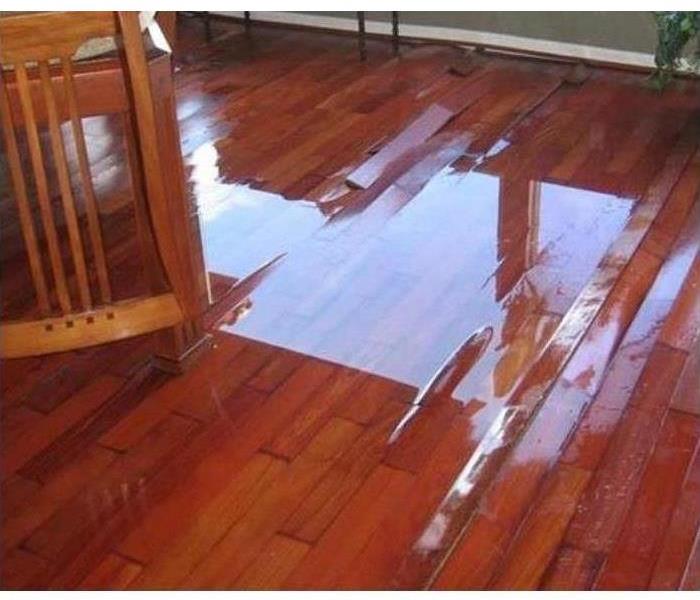Can Water Damage Repair Professionals Restore My Mango Home’s Hardwood Floors?
8/14/2020 (Permalink)
 Don't let water take over your home. Let the professionals at SERVPRO help restore your water damaged home back to its original state.
Don't let water take over your home. Let the professionals at SERVPRO help restore your water damaged home back to its original state.
No Homeowner Wants to Lose Beautiful Hardwood Floors to Water Damage -- Repair Strategies Are Successful When SERVPRO Is on the Job in Mango.
A water incursion can happen for a vast number of reasons: overflowing sinks, broken plumbing, clogged condensation drains in AC units, the rain blowing through open doors or windows, malfunctioning appliances, and more. You hope all that is needed in your Mango home is a mop-up and maybe a visit from the plumber, and all will be good again. Why do you believe you dodged a more significant disaster? The water covering your floor seems to be gone, so you were the lucky one, right?
Where Does the Water Go After Flowing Across My Hardwood Floors?
You are not alone in your hope that water damage repair to your Mango home is unnecessary. One of the most insidious and unexpected characteristics of water damage is its ability to hide from visual inspections, even by experts. A frequent place where water uses its disappearing ability is on -- and in -- hardwood floors.
Why Are Hardwood Floors Susceptible to Significant Water Damage?
The basic construction of a hardwood floor, seen in a cross-section, illuminates the pathways of water migration well. Several layers make up the floor, and the water has little trouble percolating down through them. Older floors, treasured for their burnished patina, were usually constructed quite simply:
- Floor joists supporting the upper building materials
- Subfloor, usually made of a plywood-type material, and unfinished, one layer up from the joists
- Strips and planks of hardwood installed top-side often finished with stains and sealants on the visible side, but unfinished on the edges and bottom
Newer hardwood floors might have additional layers added for resilience, creating a softer feel when walking. The water is still able to seep down between the edges and the joints between sections to reach porous materials below.
Does the Water Dry Out in the Under Layers?
SERVPRO crews often find homeowners mystified as to the reasons for their hardwood floors damage. After a spill or flooding, you cannot assume that water simply drains away or dries out quickly wherever it lands.
Where Does Water Hide and How Does the Hidden Water Hurt Your Hardwood Floor?
Do not be caught in this situation, as your seemingly dry floor will begin to show “signature” hardwood damage patterns. The unfinished wood products under the hardwood layer absorb the water readily and need some professional assistance in facilitating evaporation. As they absorb the water, they swell, putting pressure on the upper hardwood flooring. Even more importantly, they provide a ready source of moisture that the unfinished bottoms and edges of the strips and planks wick up. This moisture causes the hardwood to distort or warp as well, creating the following commonly seen damage:
- Cupping -- the edges of each piece of hardwood push up, resulting in the center of each plank or strip looking as though it is the bottom of a “cup” in cross-section
- Crowning -- the center of each plank or strip swells, (sometimes later because of over-drying)
- Buckling -- the damage is severe enough to force the hardwood to disengage from the subfloor and to curve away at joints
What Can Be Done to Save Hardwood Floors When the Underlying Layers Are Wet?
One crucial point is to call on professionals immediately, even if you cannot see the damage. Our technicians use various moisture detection and metering devices to locate and evaluate the severity of water absorption in the substrate of your floor. Then we act quickly to dry all layers to average moisture levels for your region and in unaffected areas of your home. When we determine where the moisture is trapped, we consider from among the following interventions:
- Reducing the relative humidity to 30% to 45%
- Positioning air movers to direct air floor both under and over the hardwood
- Use floor mats (flat plastic that seals to the floor and attaches to hoses connected to extractors) to pull moisture through several layers
- Adjust room temperature to increase evaporation
- Floor finishes acting as vapor barrier might be removed or perforated with a pin roller
- If accessible, dry the floor from the story beneath -- remove ceiling tiles for better flow
When water damage threatens to ruin your home’s floors, SERVPRO of Brandon / North Riverview is there for you with research-based solutions. Reduce the stress and worry of water loss with a call to (813) 741-3473 -- We’re Faster To Any Size Disaster.






 24/7 Emergency Service
24/7 Emergency Service
